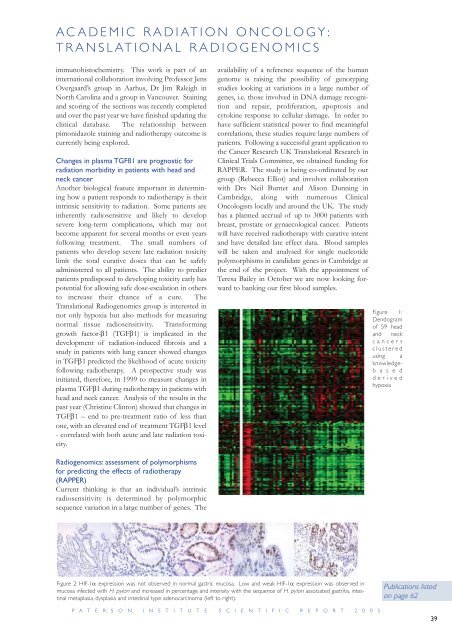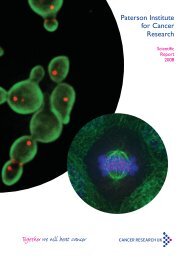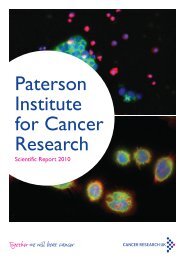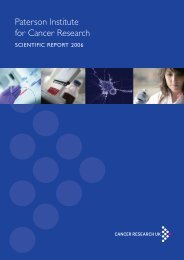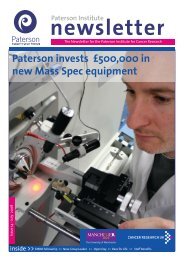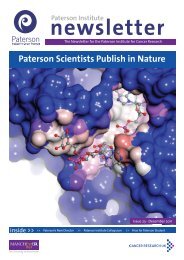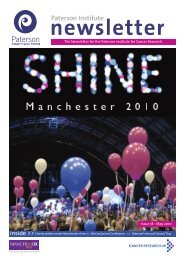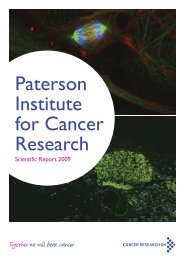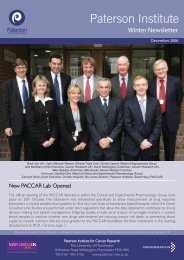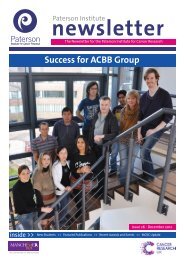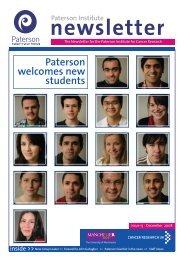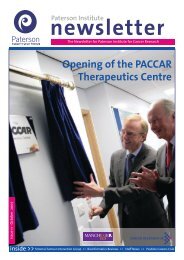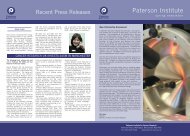Paterson Institute for Cancer Research SCIENTIFIC REPORT 2005
Paterson Institute for Cancer Research SCIENTIFIC REPORT 2005
Paterson Institute for Cancer Research SCIENTIFIC REPORT 2005
You also want an ePaper? Increase the reach of your titles
YUMPU automatically turns print PDFs into web optimized ePapers that Google loves.
ACADEMIC RADIATION ONCOLOGY:<br />
TRANSLATIONAL RADIOGENOMICS<br />
immunohistochemistry. This work is part of an<br />
international collaboration involving Professor Jens<br />
Overgaard’s group in Aarhus, Dr Jim Raleigh in<br />
North Carolina and a group in Vancouver. Staining<br />
and scoring of the sections was recently completed<br />
and over the past year we have finished updating the<br />
clinical database. The relationship between<br />
pimonidazole staining and radiotherapy outcome is<br />
currently being explored.<br />
Changes in plasma TGFß1 are prognostic <strong>for</strong><br />
radiation morbidity in patients with head and<br />
neck cancer<br />
Another biological feature important in determining<br />
how a patient responds to radiotherapy is their<br />
intrinsic sensitivity to radiation. Some patients are<br />
inherently radiosensitive and likely to develop<br />
severe long-term complications, which may not<br />
become apparent <strong>for</strong> several months or even years<br />
following treatment. The small numbers of<br />
patients who develop severe late radiation toxicity<br />
limit the total curative doses that can be safely<br />
administered to all patients. The ability to predict<br />
patients predisposed to developing toxicity early has<br />
potential <strong>for</strong> allowing safe dose-escalation in others<br />
to increase their chance of a cure. The<br />
Translational Radiogenomics group is interested in<br />
not only hypoxia but also methods <strong>for</strong> measuring<br />
normal tissue radiosensitivity. Trans<strong>for</strong>ming<br />
growth factor-β1 (TGFβ1) is implicated in the<br />
development of radiation-induced fibrosis and a<br />
study in patients with lung cancer showed changes<br />
in TGFβ1 predicted the likelihood of acute toxicity<br />
following radiotherapy. A prospective study was<br />
initiated, there<strong>for</strong>e, in 1999 to measure changes in<br />
plasma TGFβ1 during radiotherapy in patients with<br />
head and neck cancer. Analysis of the results in the<br />
past year (Christine Clinton) showed that changes in<br />
TGFβ1 – end to pre-treatment ratio of less than<br />
one, with an elevated end of treatment TGFβ1 level<br />
- correlated with both acute and late radiation toxicity.<br />
Radiogenomics: assessment of polymorphisms<br />
<strong>for</strong> predicting the effects of radiotherapy<br />
(RAPPER)<br />
Current thinking is that an individual’s intrinsic<br />
radiosensitivity is determined by polymorphic<br />
sequence variation in a large number of genes. The<br />
availability of a reference sequence of the human<br />
genome is raising the possibility of genotyping<br />
studies looking at variations in a large number of<br />
genes, i.e. those involved in DNA damage recognition<br />
and repair, proliferation, apoptosis and<br />
cytokine response to cellular damage. In order to<br />
have sufficient statistical power to find meaningful<br />
correlations, these studies require large numbers of<br />
patients. Following a successful grant application to<br />
the <strong>Cancer</strong> <strong>Research</strong> UK Translational <strong>Research</strong> in<br />
Clinical Trials Committee, we obtained funding <strong>for</strong><br />
RAPPER. The study is being co-ordinated by our<br />
group (Rebecca Elliot) and involves collaboration<br />
with Drs Neil Burnet and Alison Dunning in<br />
Cambridge, along with numerous Clinical<br />
Oncologists locally and around the UK. The study<br />
has a planned accrual of up to 3000 patients with<br />
breast, prostate or gynaecological cancer. Patients<br />
will have received radiotherapy with curative intent<br />
and have detailed late effect data. Blood samples<br />
will be taken and analysed <strong>for</strong> single nucleotide<br />
polymorphisms in candidate genes in Cambridge at<br />
the end of the project. With the appointment of<br />
Teresa Bailey in October we are now looking <strong>for</strong>ward<br />
to banking our first blood samples.<br />
Figure 2: HIF-1α expression was not observed in normal gastric mucosa. Low and weak HIF-1α expression was observed in<br />
mucosa infected with H. pylori and increased in percentage and intensity with the sequence of H. pylori associated gastritis, intestinal<br />
metaplasia, dysplasia and intestinal type adenocarcinoma (left to right).<br />
P A T E R S O N I N S T I T U T E S C I E N T I F I C R E P O R T 2 0 0 5<br />
Figure 1:<br />
Dendogram<br />
of 59 head<br />
and neck<br />
cancers<br />
clustered<br />
using a<br />
knowledgeb<br />
a s e d<br />
derived<br />
hypoxia<br />
Publications listed<br />
on page 62<br />
39


